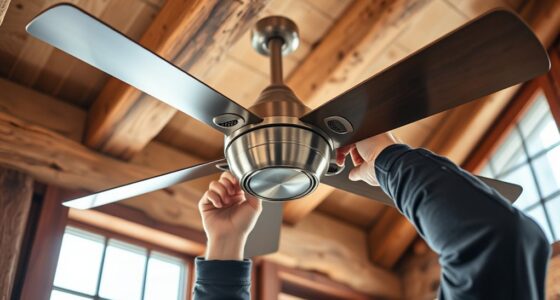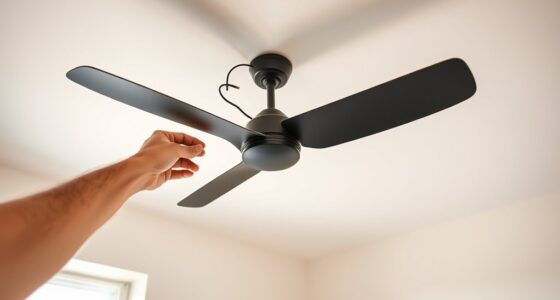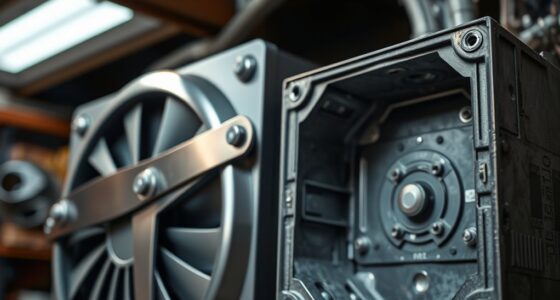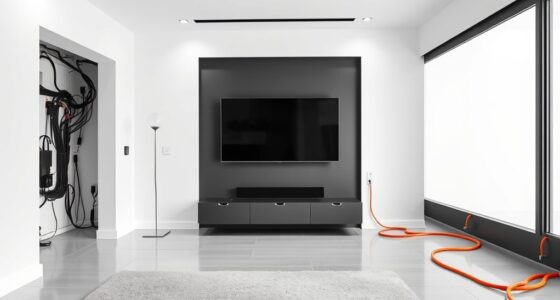To install a fan box in an old work ceiling, first make certain your ceiling can support the fan’s weight and that a proper fan box is available. Turn off the power, remove any existing fixture, and locate joists or framing for secure mounting. Use the right tools to cut an opening, install the box, and secure it to joists or drywall anchors. Carefully wire the fan, test its operation, and verify stability. Following these steps will guide you through a safe and effective setup.
Key Takeaways
- Turn off power, remove existing fixture, and inspect ceiling for damage before installation.
- Select an appropriate old work fan box designed for drywall mounting.
- Mark opening and position the box, ensuring alignment with joists or framing.
- Secure the fan box by tightening brackets or tabs to drywall or joists.
- Connect wiring safely, then test the fan operation before completing the cover.
Assessing Your Ceiling and Planning the Installation
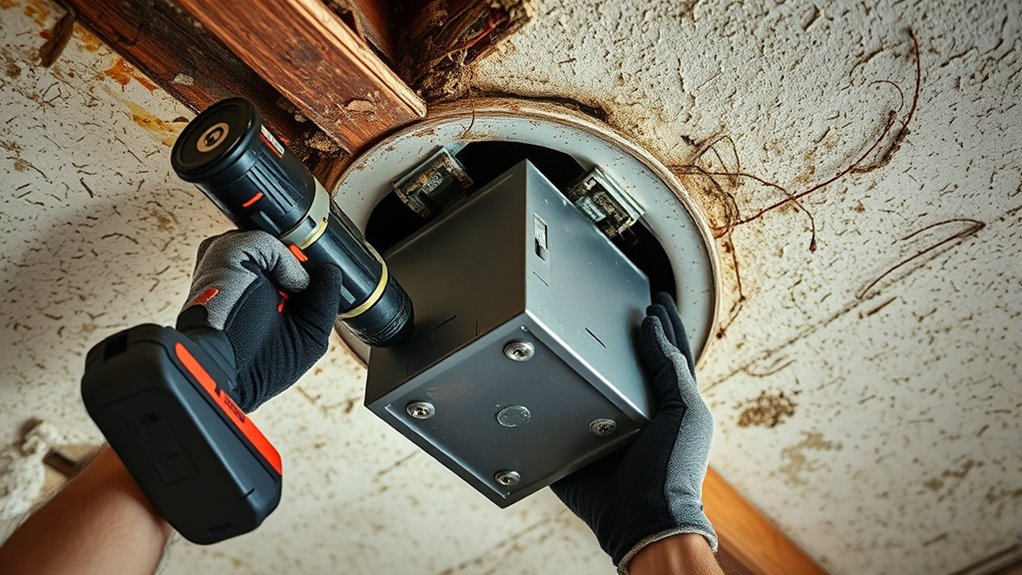
Before you begin installing a fan box in your old work ceiling, it’s essential to assess your ceiling’s structure and plan the installation carefully. Check the ceiling structure to confirm it can support the weight of the fan and the fan box. Look for existing joists or framing members that can provide a secure mounting point. Verify that your plan complies with electrical codes, including proper spacing and grounding requirements. Understanding your ceiling’s construction helps you choose the right location, avoiding obstacles like ductwork or wiring. If you’re unsure about the ceiling’s strength or layout, consider consulting a professional. Proper planning ensures safety, code compliance, and a successful installation that will last. Additionally, evaluating the ceiling’s durability can help prevent future issues with the fan installation. Being aware of building code requirements ensures your installation remains compliant and safe over time. Checking the support structure beforehand can also aid in selecting the most suitable location for mounting the fan box.
Gathering Necessary Tools and Materials
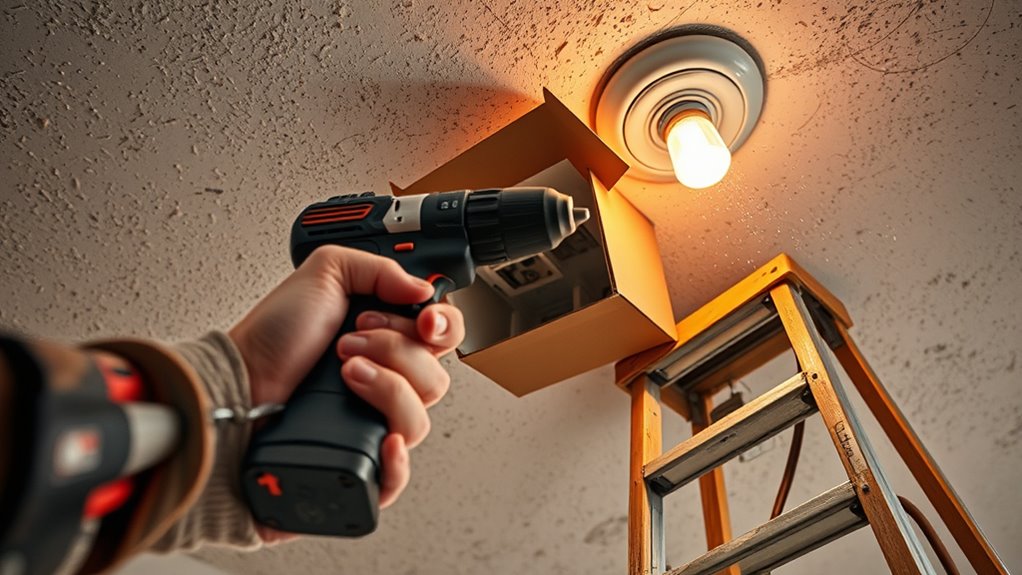
Having your tools and materials ready makes the installation process smoother. You’ll need basic hand tools like a drill, screwdriver, and a drywall saw. Make sure you have mounting brackets, which secure the fan box to the ceiling, and drywall anchors for added support if you’re attaching to hollow drywall. Gather the fan box designed for old work installations, along with a measuring tape and pencil for marking. Having these materials on hand prevents delays and guarantees a straightforward setup. Check that your drywall anchors are appropriate for the weight of the fan, and confirm the mounting brackets fit your fan box model. Preparing everything in advance helps keep the project organized and efficient from start to finish. Additionally, understanding Self Watering Plant Pots can inspire you to incorporate moisture management principles into your project, ensuring long-term durability and performance. Being familiar with installation best practices can also help you avoid common mistakes during setup.
A thorough review of power requirements ensures safe operation of your fan and helps prevent electrical issues.
Preparing the Old Work Ceiling for the Fan Box

To prepare the old work ceiling for installing the fan box, start by turning off the power to the circuit at the breaker to guarantee safety. Carefully remove any existing fixture or cover, exposing the ceiling space. Check for ceiling insulation around the area; if it’s present, gently move it aside to avoid damage and ensure clear access. Inspect the ceiling for any signs of damage or deterioration that might affect the installation. Always prioritize electrical safety by confirming the circuit is dead using a voltage tester before touching any wiring. Clear the workspace of debris and obstructions. Proper preparation ensures a safe, smooth installation and helps prevent issues related to ceiling insulation or compromised electrical components. Additionally, reviewing the correct installation techniques can help ensure the fan box is securely mounted and functions properly. Remember to consult the manufacturer’s instructions to adhere to specific guidelines for your fan box model. Ensuring that the electrical safety procedures are followed can prevent potential hazards during installation.
Installing the Fan Box and Securing It Properly
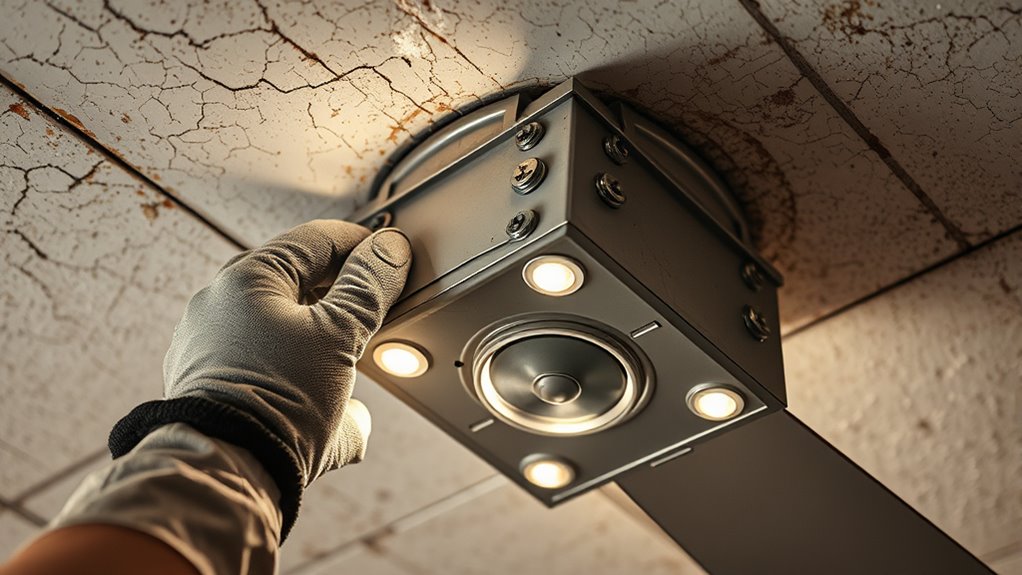
Begin by positioning the fan box in the designated ceiling opening, ensuring it’s aligned with the marked location. Use the appropriate mounting techniques based on your fan box type—metal, plastic, or remodel. For remodel fan boxes, loosen the mounting brackets, insert the box into the opening, then tighten to secure. For other types, attach the mounting brackets or tabs to the ceiling joists or drywall using screws, making sure the box is flush and stable. Keep in mind, sturdy mounting is essential to support the fan’s weight and prevent wobbling. Check that the box is level and tightly secured before moving on. Proper installation now guarantees your fan will be safe, secure, and ready for wiring in the next step.
Wiring and Testing Your New Fan Setup

Before wiring your new fan, turn off the power at the circuit breaker to guarantee safety. Once power is off, connect the fan wires according to the manufacturer’s instructions, ensuring you match the black (hot), white (neutral), and ground wires correctly. If your fan has wireless controls, follow the setup instructions to sync the remote or app for seamless operation. After wiring, turn the power back on and test the fan’s functions, including speed settings and lighting. Make sure the fan operates smoothly and responds to controls. Proper wiring and testing ensure safe, reliable performance and a polished appearance. Additionally, verifying the fan’s operation can help prevent issues like ineffective purification or malfunction, ensuring long-term satisfaction. Incorporating automation technologies can further optimize your fan’s performance and convenience.
Frequently Asked Questions
Can I Install a Fan Box in a Ceiling With Existing Insulation?
You can install a fan box in a ceiling with existing insulation, but you need to take into account insulation compatibility and wiring considerations. Ensure the fan box is rated for ceiling fans and that it fits comfortably without compressing the insulation. Carefully plan your wiring to avoid damage or shorts, working safely around the insulation. Proper installation ensures both safety and effective operation of your ceiling fan.
What Are the Weight Limits for a Fan Box in Old Work Ceilings?
You need to guarantee your fan box can support the ceiling fan weight to prevent any accidents. Most old work fan boxes are rated for a specific ceiling fan support weight, typically around 35 to 70 pounds. Always check the manufacturer’s guidelines for the fan box weight limit, and make sure it’s sufficient for your ceiling fan. Proper support ensures safety and stability for your installation.
How Do I Ensure Proper Clearance Around the Fan for Safety?
To guarantee proper clearance around your fan for safety, you need to follow ventilation requirements and clearance measurements specified by the manufacturer and local codes. Make sure there’s enough space between the fan blades and nearby walls or ceiling joists to prevent obstructions. Proper clearance not only improves airflow but also reduces safety risks. Always double-check measurements before installing, and consult local building codes to guarantee compliance and ideal performance.
Is Additional Support Needed for Heavy Ceiling Fans in Old Work Boxes?
When installing a heavy ceiling fan, you need to consider support requirements to ensure safety. For installation considerations, verify that the old work box can handle the weight or add support bracing if necessary. If the fan is particularly heavy, you might need to reinforce the box or use a fan-rated box designed for heavy loads. Always follow manufacturer guidelines and local codes to ensure proper support and secure installation.
Can I Install a Fan Box Without Accessing the Space Above the Ceiling?
Did you know that over 60% of DIYers prefer wireless installation for convenience? You can install a fan box without accessing the space above the ceiling by opting for surface mounting. This method allows you to securely attach the box directly to the ceiling surface, making it ideal for old work ceilings. Just guarantee the surface is sturdy enough to support the fan’s weight, especially for larger models.
Conclusion
With careful planning and proper installation, your new fan box will blend seamlessly into your old work ceiling. Don’t worry about the complexity—taking your time guarantees safety and a professional finish. If you’re concerned about compatibility with existing wiring, consulting a professional can provide peace of mind. Ultimately, your effort will pay off with improved comfort and airflow, transforming your space without the need for costly ceiling repairs.


